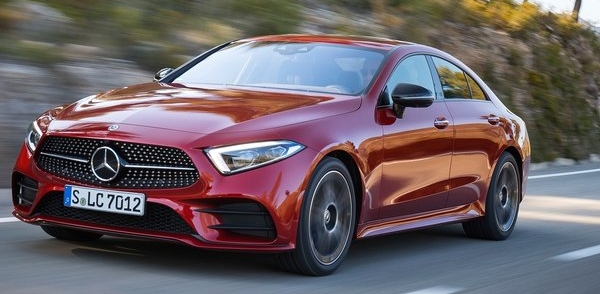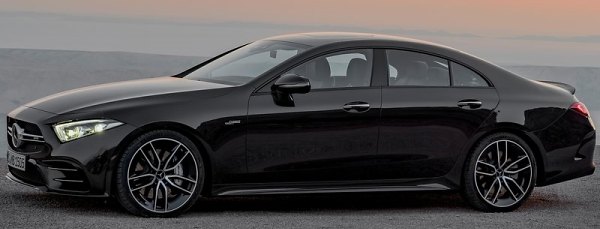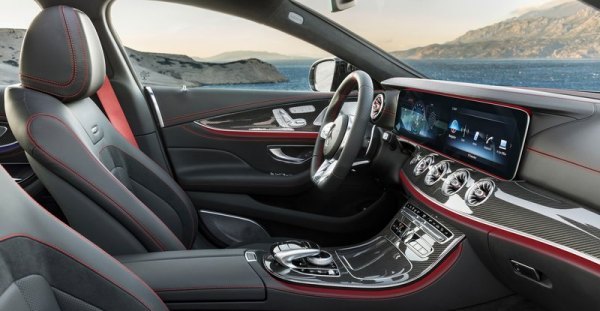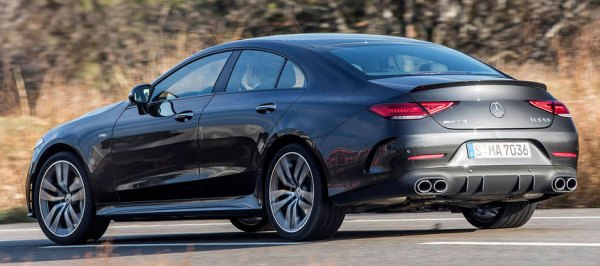Published
on 10
Mar 2018
|
All rights reserved.
|
|

|
|
Now
sitting under AMG GT 4-door, can the CLS shine as bright as before?
|
|
Time flies. The
trend-setting Mercedes CLS-class enters the third generation. In the
past 14 years, it captured 375,000 units of sales or an average 27,000
units annually. Massive numbers? Not quite, but by no means poor
considering this is a
niche car. It is derived from the component set of the mass-selling
E-class (about 300,000 units built a year) yet charges a premium of 20
percent, so its profit margin should be quite attractive. No
wonder Mercedes is willing to renew the CLS even in the fever of SUV
goldrush. In the market, the CLS has only two direct competitors: Audi
A7 and BMW 6-Series Gran Coupe (to be replaced with 8-Series Gran
Coupe soon). Compared with them, the inventor of the class still has a
psychological advantage.
However, this time around its market strategy is different.
In order to promote the AMG brand, another 4-door coupe
derivative is developed alongside the CLS. It is called AMG GT 4-door.
Both cars sit on the same E-class underpinnings with the same wheelbase
and high-percentage of common components, but the AMG is faster,
sportier, classier and
pricier. Inevitably, the new CLS has to be more restrained. It loses
all V8 engines, including the full-blooded AMG ’63 model. Now its
range-topper becomes the half-hearted AMG CLS53, powered by a
turbo-and-electric-charged 3-liter straight-six coming from Mercedes
production line instead of the technicians of Affalterbach. The
chassis
tuning is also more civilized to distant it further from the true AMG
car. Will the two-tier strategy work? Or just steal sales from each
other? We have to observe over time, but car enthusiasts won’t mind
seeing more cars like these.

|
|
Beautiful
shape remains, but CLS53 is rather understated for an AMG...
|
|
Yes, especially when the car looks this good. The CLS has
always been an artistic sculpture, and this one is no different. It
retains the signature banana-shape side profile with a swoopy roof line
extended seamlessly from the nose to tail, and the shallow glasshouse
employs heavily tapered frameless windows to appear like a coupe. It
certainly looks more dramatic than both its German rivals. The new
shape has a low drag coefficient of 0.26, the same as the last
generation. Compared with the E-class saloon it is 33mm lower and 38mm
wider, while front and rear overhangs are slightly longer. On the
downside, I am not a fan of its larger, more upright front grille,
which makes the bonnet too long and the sense of sleekness hurt a
little.
Sadly, Gorden Wagener is turning all Mercedes models like this – see
the
new A-class for example.
There are again two different grille designs available, between them I
reckon the
regular Mercedes grille (red car above) looks classier than the AMG
grille (black car above) thanks to its diamond-style elements. As the
front bumper of both cars are virtually
the same, it is not necessary to pay the premium for looks alone.
The AMG ’53 model does sports a more aggressive rear end, which
consists of a small lip spoiler, quad-exhaust and four vertical fins on
what appears to be a
pseudo diffuser. Still, this is a
rather
understated design for an AMG model.
 |
|
The
swooping roof line means 6-footers are prohibited from the rear seats.
|
|
Another disappointment is the cancellation of the Shooting Brake
derivative. Mercedes reckons a niche model within a niche product line
is probably too niche to be realistic. What a pity, as the old Shooting
Brake was truly unique on the road. It beat the coupe for both looks
and practicality.
At least, the new cabin has gained a 5th seat for improved
practicality. While the last two generations employed 2 individual rear
seats to emphasize the sportier character of CLS compared with E-class,
Mercedes found it can no longer do so because Audi A7 offers a bench
seat. Like the case of Audi, the middle rear seat here is only suitable
to a short trip in emergency, because not only its cushion is harder
but there is simply not enough space
to fit 3 adults. Predictably, the two normal rear seats are not for
tall guys either. 6-footers will find their heads rubbing against the
sloping roof liner, an inevitable price paid for the coupe shape.
Up front, it looks remarkably like an E-class, albeit with a lower
roof, shallower windows and some styling enhancements making it look
sportier. The dashboard architecture is familiar to the owners of
E-class, as is the twin-12.3-inch touchscreen. We still miss the
classic wood-and-leather interior of the first generation CLS, but
these days
the Mercedes standard cabin design is so high-quality, elegant and
advanced that
few could resist the temptation – not even those used to the standards
of Audi. Moreover, it has the E-class’ 6 circular air vents converted
to jet turbine-style units with illumination that can change color
according to temperature setting. Too gimmicky for you? Then look at
the AMG model’s stitched nappa leather trims and AMG steering wheel. It
means business.

|
|
Familiar
or not, this place is so high-quality, elegant and advanced that few
could resist the temptation...
|
|
As V8 is no more, the new CLS relies on the new M256 gasoline and OM656
diesel straight-6 debuted on S-class last
year. The petrol unit of
CLS53 employs a large twin-scroll turbocharger to produce 435
horsepower and 383 pound-foot of torque, which is quite remarkable for
the 3-liter class considering its counterparts from BMW and Audi manage
only 340hp. A large exhaust-gas turbo should have resulted in a lot of
turbo lag, but Mercedes added an electric charger to speed up low-end
response.
Furthermore, an integrated starter generator (ISG) working with 48V
lithium battery provides another 22hp and 184 lbft of torque in
short periods to fill the torque gap. This so-called EQ-Boost
mild-hybrid system also cuts fuel consumption by using the ISG instead
of the engine to propel the car during coasting, and
recharges the battery through regenerative braking. By the way, the
electric charger is also supplied by the 48V system because of its high
power consumption. The new Mercedes straight-six is really state of the
art.
The lesser CLS450 runs much the same engine, but it uses a smaller
turbo and skips the electric charger, dropping output to 367hp and 369
lbft. Similarly, the new diesel straight-six of CLS350d
and CLS400d differ in details and tune, i.e. 286hp / 442 lbft versus
340hp /
516 lbft. All of them are paired with 9G-Tronic gearbox and drive all
four wheels – the regular models through the 31:69 permanent 4matic
system,
whereas CLS53 employs the rear-biased active 4matic+. Later on,
there will be an entry-level CLS350 powered by the new M264 2-liter
turbo with around 300hp, but I suppose 6-cylinder is the minimum
requirement for a true Mercedes luxury coupe, isn't it?

|
|
The
straight-6 has a very linear power delivery, not unlike BMW's but with
added shove.
|
|
How do these six-cylinders behave in the real world?
Surprisingly, the petrol straight-six has a very linear power delivery,
much like a small normally aspirated V8. It is lag-free, very smooth
and quiet, not unlike BMW straight-six but with added shove. Despite
its AMG badge, the CLS53
feels very civilized. It claims a 0-60 mph time of 4.3 seconds, which
is quick, but at no point it feels as explosive or as wild as its badge
leads you to believe. Its exhaust note is musical, just as expected for
a great straight-six, but the cabin is so well insulated from the
outside world that you can hear little. Moreover, AMG has its trademark
pops and crackles reserved for its full-blooded models, so the CLS53 is
a fast and comfy daily companion rather than a car you would prefer to
drive
on a Sunday morning. This probably makes the CLS400d more sensible,
because it feels hardly
slower in the real world thanks to its superior torque, while
it is also remarkably quiet and refined.
As for ride and handling, it is slightly sportier than the regular
E-class but not as hardcore as the E63. The CLS53 is fitted with air
suspension and adaptive dampers as standard, but it rides remarkably
smooth and quiet as its suspension tuning is softer than that of the
E63 and its rubbers are less aggressive. In corners, body roll is
well contained. Benefited from unique steering knuckles and increased
negative camber, the steering of CLS53 is precise and responsive, and
it feels more communicative than the numb steering of lesser models as
well as E-class. Otherwise, the CLS450
behaves very close to the AMG model, sacrificing just a little bit body
control and braking power. In fact, to leave room for the AMG GT
4-door, Mercedes imposes a ceiling to the CLS, limiting its spicy
flavours. This means, those appreciating the CLS will be less
enthusiastic drivers who chase a beautiful shape in the first place.
Problem is, the AMG GT 4-door seems to be more beautiful as well. In
the end, the CLS’ attraction over its sister car is only a more
affordable price. How well this 2-tier strategy works remains to be
seen. If the AMG is proved to be more popular, there
might be no future for the CLS.
|
Verdict:     |
|